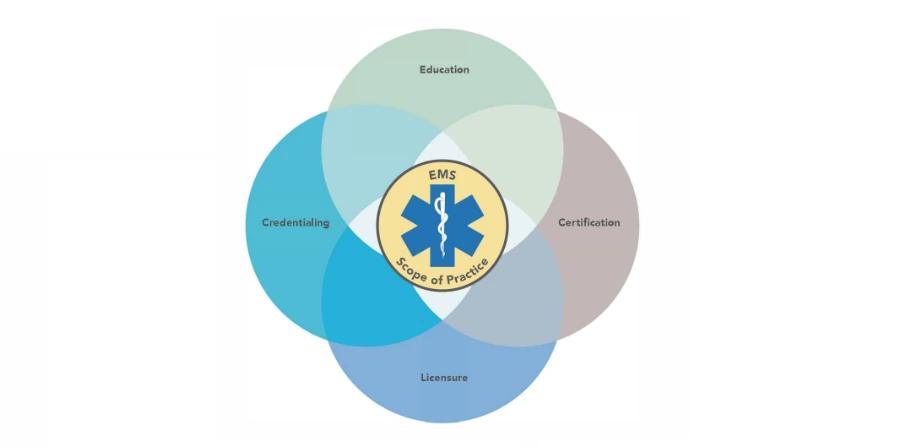The National EMS Scope of Practice Model has evolved significantly since its inception in 2007. By 2024, this model has integrated the latest evidence and best practices in emergency medical care, emphasizing the importance of a standardized, evidence-based approach across the United States. It addresses the dynamic nature of emergency medical services, ensuring that EMS professionals are equipped with the necessary knowledge and skills. The model’s updates reflect changes in medical technology, protocols, and the need for a more adaptable and responsive EMS system.
Evolution of the EMS Scope of Practice Model
Initial Development and Purpose
The EMS Scope of Practice Model was first established to create a unified standard for EMS practitioners. It aimed at defining the roles, responsibilities, and educational requirements for EMS professionals across various levels. This initial version laid the groundwork for a national approach to EMS education and practice.
Major Revisions and Updates
By 2019, significant revisions were introduced, incorporating new medical practices, technologies, and the experience gained over the years. These updates were designed to enhance clinical competence and improve the efficiency of EMS education and practice. The model now includes provisions for rapid updates to address urgent public health needs, such as pandemics or natural disasters.
Impact on EMS Education and Practice
Standardizing EMS Education
The model has played a crucial role in standardizing EMS education, ensuring that training programs across the country meet a set level of quality and comprehensiveness. This standardization supports the consistency of care provided by EMS professionals, irrespective of their state or region.
Enhancing Clinical Competence
With the integration of new medical evidence and best practices, the model ensures that EMS professionals are clinically competent to handle a range of medical emergencies. This competence is critical for effective response in both routine and complex emergency situations.
Key Components of the EMS Scope of Practice Model
Levels of EMS Certification
The model defines four levels of EMS certification: Emergency Medical Responders, Emergency Medical Technicians, Advanced EMTs, and Paramedics. Each level has specific knowledge and skill requirements, ensuring that EMS professionals are prepared for their respective roles.
Integration with National EMS Education Standards
The Scope of Practice Model is closely integrated with the National EMS Education Standards. This integration ensures that EMS education programs provide the necessary training for each certification level, aligning with the competencies outlined in the model.
Impact on EMS Education and Training
The integration of new standards emphasizes a comprehensive approach, addressing emergent public health needs, pediatric and geriatric care, and behavioral health. Education now reflects the broader scope of EMS responsibilities, incorporating cultural humility, EMS operations, pharmacology, and wellness. The focus is on creating clinicians who are not only competent in medical skills but also attuned to the diverse needs of the communities they serve.
Evolving Practices in EMS
The latest standards signify a shift towards a more holistic view of patient care. Special attention to pediatrics and geriatrics indicates an acknowledgment of the demographic spectrum of patients. Furthermore, the inclusion of cultural humility in the training curriculum prepares EMS professionals to deliver care with a deep respect and understanding of diverse cultural backgrounds.
Legal and Ethical Considerations
The updated Scope of Practice Model and Education Standards reflect legal and ethical evolutions within EMS. They emphasize the importance of staying informed about legislative changes and ethical dilemmas, ensuring that EMS practitioners can navigate the complex landscape of healthcare provision effectively.
Final Reflections
In conclusion, the updates to the National EMS Scope of Practice Model and the EMS Education Standards represent a significant advancement in EMS training and practice. They aim to prepare EMS professionals for a future where they can effectively respond to an increasingly complex and diverse set of healthcare needs.
The integration of new educational standards, focusing on comprehensive care, acknowledges the evolving role of EMS in public health and community well-being. This progression in EMS education and practice underscores the importance of continuous learning and adaptation to improve patient care and community health outcomes .
Frequently Asked Questions
How does the National EMS Scope of Practice Model address mental health emergencies?
The model has evolved to include comprehensive guidelines for handling mental health emergencies. It emphasizes the importance of EMS professionals being equipped with skills in psychiatric evaluation, crisis intervention, and the safe transport of patients experiencing mental health crises. This ensures that patients receive appropriate care and are directed to suitable mental health facilities.
What role does technology play in the updated EMS Scope of Practice Model?
Technology plays a pivotal role in the updated model, with the integration of telemedicine, electronic patient care records, and advanced diagnostic tools. These technological advancements enable EMS professionals to deliver more accurate and efficient care, improve patient outcomes, and enhance real-time communication with hospital staff.
How does the updated model ensure the quality of EMS education and training programs?
The updated Scope of Practice Model is integrated with the National EMS Education Standards, ensuring that all EMS education and training programs meet the required quality. Accreditation bodies assess these programs against the standards, guaranteeing that they provide the necessary knowledge and skills for EMS professionals.
How does the Scope of Practice Model influence the licensure and certification of EMS professionals?
The model outlines the competencies required at each level of EMS certification and serves as a benchmark for state licensing boards. It ensures that EMS professionals meet the national standards before they can be licensed or certified, promoting consistency in the quality of emergency medical care across the United States.
Reference Links
-
EMS.gov’s National EMS Scope of Practice Model
The official guide on the National EMS Scope of Practice Model, reflecting the latest practices in EMS care.
-
NASEMSO’s EMS Scope of Practice Model
Provides insights into the development and revisions of the National EMS Scope of Practice Model.
-
National Registry of Emergency Medical Technicians
Offers information for EMS educators and programs, highlighting the integrated approach to EMS education and practice.
-
EMS1’s article on the New National EMS Scope of Practice Model
Details the release and contents of the updated National EMS Scope of Practice Model.
-
National Conference of State Legislatures (NCSL) on EMS Workforce Shortages
Discusses state actions and policies influenced by the National EMS Scope of Practice Model to address EMS workforce shortages.

Jeromy VanderMeulen is a seasoned fire service leader with over two decades of experience in emergency response, training, and public safety management. He currently serves as Battalion Chief at the Lehigh Acres Fire Control & Rescue District and is CEO of the Ricky Rescue Training Academy, a premier provider of online and blended EMT and firefighter certification programs in Florida.
Jeromy holds multiple degrees from Edison State College and the Community College of the Air Force, and is pursuing his MBA at Barry University. He maintains top-tier certifications, including Fire Officer IV, Fire Instructor III, and Fire Inspector II, and has served as a subject matter expert for a court case. He is a member or the Florida Fire Chiefs Association.
Jeromy also contributes to state-level fire safety regulation and serves on several hiring and promotional boards.

